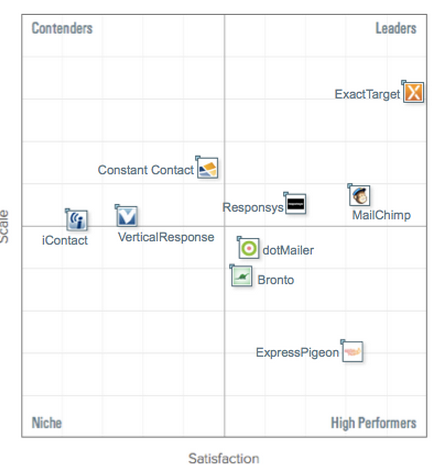
Startup Takes Aim at Gartner with Crowdsourced Analytics
If you’re looking to purchase an enterprise software product, you may have pondered paying a big IT analyst group like Gartner, IDC, or Forrester for professional advice. But in the future, you may do just as well getting your data from G2 Crowd, a startup that aims to combine crowdsourced product reviews with big data analytics to create tailored product recommendations in the enterprise app space.
 G2 Crowd launched earlier this year with the novel idea that it could do for enterprise software buying decisions what Yelp does for people’s decisions about which restaurants to visit. The idea was to give website visitors free access to targeted product recommendations based on reviews from other people with similar profiles.
G2 Crowd launched earlier this year with the novel idea that it could do for enterprise software buying decisions what Yelp does for people’s decisions about which restaurants to visit. The idea was to give website visitors free access to targeted product recommendations based on reviews from other people with similar profiles.
“There’s all this information out there now–somewhere online, on the Web, on the social network–and we’re gathering all of that data, and we’re applying that algorithms to essentially make recommendation about which software would best fit them,” says Godard Abel, who co-founded the company with two colleagues from BigMachines, the developer of configuration, pricing, and quoting software that he also co-founded, and which was recently bought by Oracle.
Currently, there are about 15,000 reviews on products in five product categories, including CRM, sales force automation, marketing automation, email marketing, and help desk products. In the future, the company hopes to add reviews for additional enterprise software categories, such as ERP, financials, human resources, supply chain management, and big data. (Getting good info on big data products is tough, Abel says, due to all the hype and shifting definitions of what exactly “big data” means.)
For each product category, G2 Crowd publishes a grid, which Abel says is similar to Gartner’s Magic Quadrant, except for the fact that it’s dynamic, updated in real time, and can be tailored to a user’s particular needs. “So for CRM, the enterprise version of the grid include Salesforce.com, Oracle, and SAP. The SMB version might still have Salesforce, but instead of Oracle and SAP, it has new emerging vendors that can better serve SMB customers,” Abel says.
If Abel sounds a little sour about the product recommendations that come from the big analyst firms, it comes from his experience at BigMachines. “I ran the company for 11.5 years after starting it, and we dealt with Gartner as a vendor client,” he tells Datanami. “We just found it to be, as a vendor, very frustrating. It took us five to six years just to get into the first report, because they have size and exclusion criteria. Especially if you’re tiny vendor, and you’re not spending money with them, you’re just not going to be in the report.”
 As BigMachines got bigger, it had the cash to spend on Gartner. “But it didn’t feel good because we were paying for strategy sessions, not really to get strategy advice, but [because] we knew it would give us more face time with analysts and allow us to get our message across, which we thought at the margin would help our rating,” he says. “I think everybody’s knows how the game’s played. But it doesn’t quite feel right. It’s a little like how the investment banks make all their money from the big corporate clients that their analysts are also covering. It’s hard to provide unbiased opinions when they’re paying the bills.”
As BigMachines got bigger, it had the cash to spend on Gartner. “But it didn’t feel good because we were paying for strategy sessions, not really to get strategy advice, but [because] we knew it would give us more face time with analysts and allow us to get our message across, which we thought at the margin would help our rating,” he says. “I think everybody’s knows how the game’s played. But it doesn’t quite feel right. It’s a little like how the investment banks make all their money from the big corporate clients that their analysts are also covering. It’s hard to provide unbiased opinions when they’re paying the bills.”
Abel isn’t necessarily gunning for Gartner with G2 Crowd. In fact, he says he wouldn’t mind if analysts from the group used the product recommendations in their engagements with clients. But he does clearly think the time has come for a more data-driven approach to enterprise software buying, and that will bring him up against Gideon’s IT consulting juggernaut.
“I think we will be disruptive to Gartner’s Magic Quadrant because it’s just a more real-time, democratic, and better way to rate and recommend products,” he says. “What we think about a software product doesn’t matter. What we’re creating is a big data platform where we’re gathering reviews on our own site.”
The G2 Crowd platform gets reviews in two ways. First, users can log into the website using their LinkedIn credentials, which the company uses to confirm identity and to automatically build profiles about reviewers. There are about 8,000 reviewers currently confirmed by the system, with hundreds more being added every day, Abel says. The website platform also sucks in reviews from the big app stores, such as Google Play and the Apple App store, as well as from Twitter and other cloud sources.
The level of detail in each review gives the G2 Crowd system lots of data to manipulate and base recommendations on. G2 Crowd tailors the review questionnaires to specific enterprise products, and asks the reviewer about 65 questions about the product, Abel says. G2 Crowd will also pay people for reviews, and also give them badges that they can display on their LinkedIn profiles.
Employees of enterprise app vendors are not allowed to submit reviews on their products or their competitors’ products; LinkedIn profiles are critical for enforcing that. “That level of transparency about who the reviewer is really helping us to make sure that we don’t have any kind of blatant fraud,” Abel says.
 |
|
| G2 Crowd CEO Godard Abel is bringing a combination of crowdsourced data and big data analytics to bear on the enterprise application selection process. | |
Once the data is in place, it’s up to the G2 Crowd technical team to get the most out of it, and to keep the grids updated with the latest reviews. The data grids are free to access; the company makes money by selling premium products, such as downloadable spreadsheets and PDF presentations that contain the same information that’s on the website.
The 10-person company doesn’t employ a “data scientist” per se. But considering Abel’s background–which includes McKinsey consulting, MIT, Stanford Business School, in addition to co-founding the $100-million-company, BigMachines–he and his colleagues get by.
“We’re not true data scientists, but we think we know enough about statistics and data that we’ve been developing the basic algorithms and tuning them ourselves,” he says. “We’re looking at the data, we’re capturing some other social and online sources, and we aggregate that and it all feeds into our rating engines. The nice thing is, there are more and more signals and data out there. Over time, we’re doing and more and more with the data to give contextual recommendations and relevant information to the software buyers.”
According to Abel, the end is near for the old way of getting product recommendations. “We do think the trend is toward more openness, especially with the younger generation of employees and the companies that want to recruit them,” he says. “We think there’s enough credible reviewers who will share, and will share with their identity. Given the existence of LinkedIn, 20 years ago, that would have totally freaked out every corporation in the world. But you can’t fight it. You can’t tell your employees not to be on LinkedIn. The world is headed to that openness.”
Related Items:
Big Data Getting Big Bucks from VC Firms
The Big Data Market By the Numbers
Top Three Big Data Startups at Strata






























